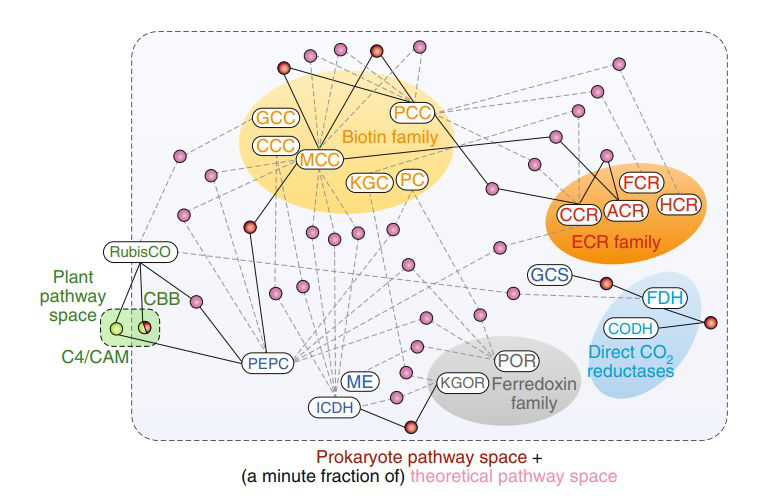
Biological carbon sequestration is an important part of the Earth's carbon cycle process. Several natural biological carbon sequestration pathways have been discovered in nature, but the natural pathways are not only inefficient in energy utilization, but also difficult to be artificially modified to enhance carbon sequestration efficiency. With the development of synthetic biology, new artificial carbon sequestration pathways have emerged. Compared with natural pathways, artificial carbon sequestration pathways have the advantages of short routes, low energy consumption and high atomic economy, and are expected to replace natural carbon sequestration pathways in the near future to achieve a significant increase in carbon sequestration efficiency, which is one of the effective ways to solve human energy and environmental problems.

In 2016, Tobias J. Erb's group at the Max Planck Institute in Germany reported in Science a new unnatural enzyme-catalyzed CO2 fixation pathway, the CETCH cycle, which is more efficient than the natural Kelvin carbon sequestration cycle. However, the CETCH cycle requires the consumption of expensive ATP and NADPH for energy supply, making it unavailable for large-scale use. Recently, Tobias J. Erb's group at the Max Planck Institute in Germany, in collaboration with Jean-Christophe Baret at the University of Bordeaux in France, published a paper in Science entitled "Light-powered CO2 fixation in a chloroplast mimic with natural and synthetic parts" in Science. In the paper, the natural chloroplast membrane (thylakoid membrane) was perfectly integrated with various enzymes of the CETCH carbon fixation cycle by droplet microfluidics to build an artificial chloroplast that can use light as an energy source with greater efficiency than natural ones (shown below). This artificial chloroplast is able to produce energy molecules ATP and NADPH through photosynthesis, and further efficiently convert CO2 into chemical raw material hydroxyacetic acid.

Extraction of cystoid from spinach chloroplasts and preparation of artificial chloroplasts by droplet microfluidics combined with multiple enzymes of the CETCH cycle
We first isolated cystoid membranes from spinach chloroplasts and experimentally demonstrated that the isolated cystoid membranes were capable of reducing NADP+ to NADPH and converting ADP to ATP under light conditions. /reductase (Ccr)) and propionyl-CoA carboxylase (Pcc), the enzymes required for the CO2 fixation reaction. On this basis, it was confirmed that the vesicle-like membrane is compatible enough to provide the 16 enzymes required in the CETCH cycle as well as the glyoxylate reductase. It is worth mentioning that the enzymes in the CETCH cycle come from a variety of species, including plants, animals and microorganisms, and it is the shortest reaction pathway and the least energy consuming carbon fixation cycle among the carbon fixation pathways that have been discovered by humans so far. As shown in the figure below, the cystoid membrane and the CETCH cycle achieve a perfect combination. The cystoid membrane can produce NADPH and ATP under light conditions, and NADPH and ATP can supply energy to the CETCH cycle, and the CETCH cycle fixes carbon dioxide into glyoxalate, which can be reduced to industrial raw material hydroxyacetic acid by NADPH in the system.

The CETCH cycle based on vesicle-like membrane is able to utilize the light function and the carbon sequestration efficiency exceeds that of the natural Kelvin cycle
Due to the limitations of volume limitation, self-shading effect, and inability to monitor in real time for the ontology experiment, droplet microfluidics was designed to achieve the needs of scale up, high throughput, and real time monitoring. As shown in the figure below, droplet microfluidics prepared water-in-oil droplets with vesicle-like membranes and multiple enzymes inside the droplets, and the droplets with reactivity were screened by NADPH fluorescence. By comparing the native group, the droplet microfluidic group, and the no-light control group, it was found that the droplet microfluidic technique could significantly improve the CO2 conversion efficiency of the artificial chloroplasts. It was able to produce 47 ± 5 micromoles of hydroxyacetic acid in 90 min time.

(A) Preparation of artificial chloroplasts by droplet microfluidics; (B) Artificial chloroplast work cycle; (C) Comparison of carbon sequestration efficiency under native, microfluidic droplet, and dark conditions
In conclusion, this is a method that perfectly integrates natural biosynthesis and artificial biosynthesis techniques to prepare artificial chloroplasts with the potential to surpass natural photosynthesis. With the ability to obtain light energy to solidify CO2 and obtain industrial feedstock, artificial chloroplasts will have important applications in artificial biosynthesizers and even in artificial living systems. The synthesis of artificial chloroplasts is important for facing the challenges of global warming and fossil fuel sustainability, and is a landmark work in the field of synthetic biology.

Anhui Yuanchen Environmental Technology Co., Ltd (hereinafter referred to as "Yuanchen Technology") is a high-tech enterprise integrating R&D, production and sales of dust removal bags and denitrification catalysts. Over the past sixteen years, Yuanchen Technology has been focusing on the environmental protection field, and now has 4 international PCT, 33 authorized invention patents and 77 invention patents in process, among which many products such as "dust removal and denitrification integrated technology products" have been awarded the Scientific Progress Award of Anhui Province. Our dust removal bags (mainly PPS, PTFE, P84 and composite series needle felt) and SCR denitrification catalysts have been widely used in cement, steel, glass kilns, waste incineration power generation, biomass power generation, non-ferrous metal smelting and other industries.
In the future, Yuanchen Technology will be guided by "becoming the guardian of global ecological environment", always rooted in environmental protection, and insist on the great cause of guarding the blue sky and white clouds. Leveraging on the national ecological civilization construction pattern, we will continue to deepen technology, optimize management, strengthen brand, refine industry and solidify advantages, and create synergistic value for industry through comprehensive and integrated governance and services.